Backyard on a Slant? 8 Creative Ways to Level Your Slope
Ever feel like your backyard is auditioning for an extreme sports competition? Yeah, me too. That irritating slope can be a real buzzkill for picnics, games, or even just relaxing with a good book.
But fear not, you are not alone with this problem and the good news is that we can transform a slanted yard into a stunning and functional space. With a few creative solutions, your slope can become the perfect spot for gatherings, gardening, and unwinding.
There are a number of ways to level a sloping backyard. Some may require complex engineering solutions while others are fairly easy to implement. A lot will depend on the gradient and length of the slope you have. Here we will explore some practical and fun ways to level out your yard that should be possible with resorting to difficult gradient correction techniques and which will result in you being able to make the most of every inch.
#1 Embrace the Levels: Terraced Lawns
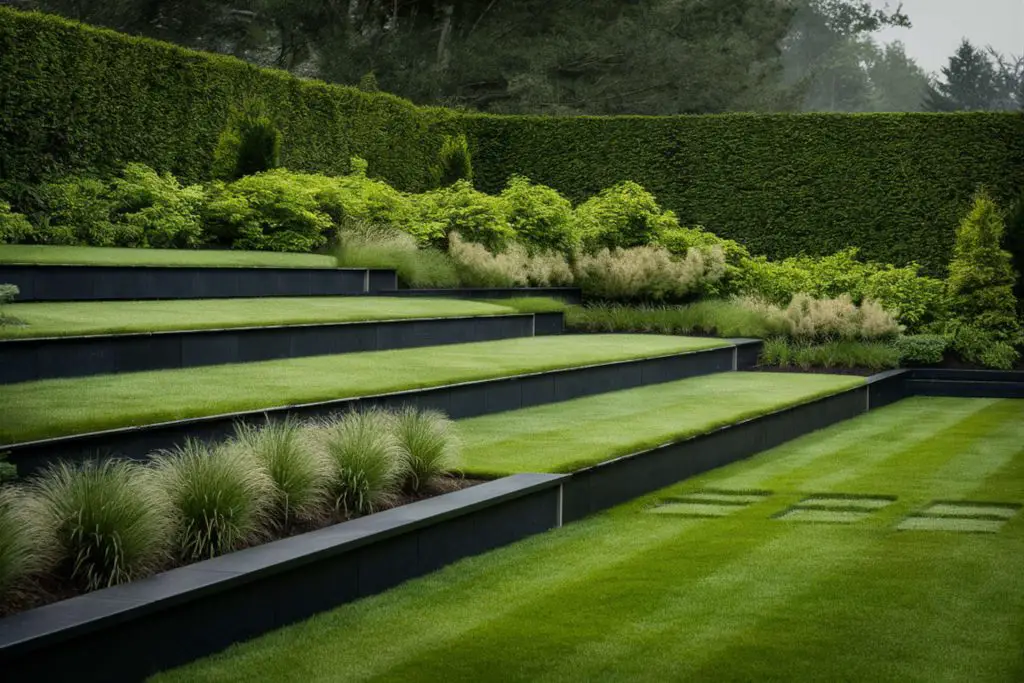
Terraced lawns involve creating mini-levels supported by retaining walls, transforming a steep slope into a series of manageable, flat areas. This technique not only maximizes usable space but also adds a dynamic visual appeal to your backyard. By breaking up the slope, you create distinct zones that can be used for different purposes, such as gardening, lounging, or playing.
For a personal touch, consider using natural stone or wood for the retaining walls to blend seamlessly with your garden’s aesthetic. One of my favorite DIY tips is to plant creeping thyme or low-growing sedum along the edges of the terraces. These hardy plants not only soften the look of the retaining walls but also provide lovely bursts of color throughout the growing season.
#2 Hold Back the Hill: Retaining Walls
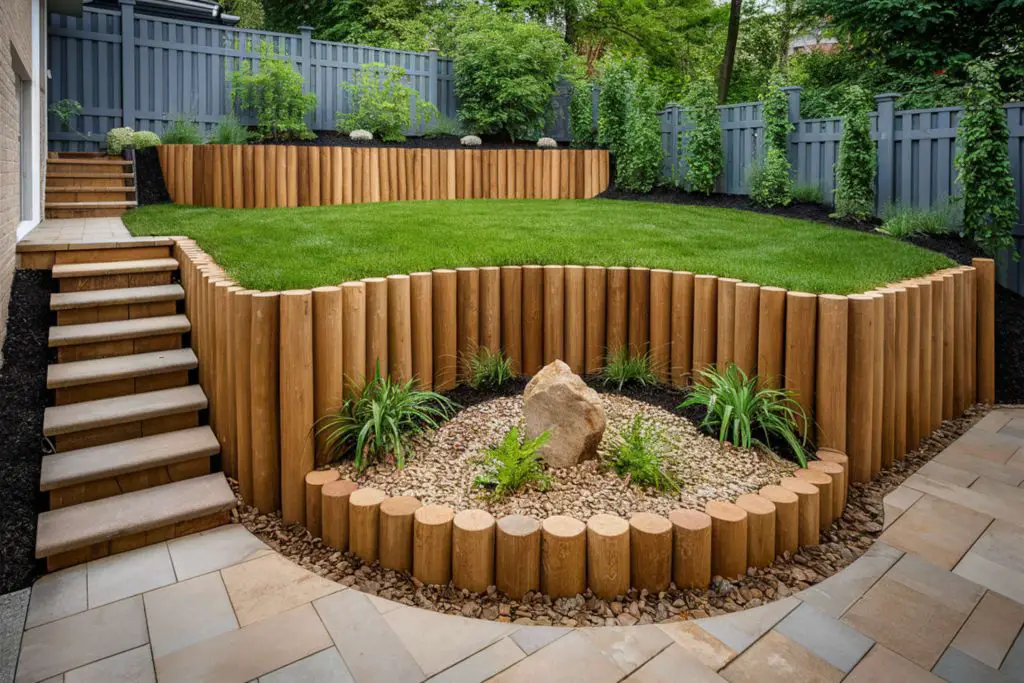
Retaining walls are structures designed to hold back soil, preventing erosion and creating flat, stable areas on a slope. These walls can be both functional and visually appealing, making them a popular choice for backyard transformations.
You can get creative with materials for retaining walls. Stone offers a natural, timeless look, while wood can give a rustic charm. Concrete blocks are durable and versatile, allowing for various designs and finishes. Consider incorporating built-in seating or planters into your retaining walls for added functionality and aesthetic appeal.
I once saw a project where a homeowner used large stones to create a series of curved retaining walls. They integrated wooden benches between the walls, creating a cozy and inviting outdoor seating area. This clever use of space made the backyard both practical and beautiful.
3# Upcycle Your Way to Level: Using Old Pallets

Using old pallets for raised beds is an innovative way to level your sloped backyard while being budget-friendly and eco-conscious. Pallets can be easily transformed into sturdy, elevated garden beds, creating instant flat surfaces perfect for planting.
The benefits are numerous: pallets are often free or inexpensive, they promote recycling, and they can be adapted to fit any garden style. To get started, disassemble the pallets and use the wood to build rectangular frames. Place these frames on your slope, fill them with soil, and you’re ready to plant.
For a simple DIY guide, start by finding pallets in good condition. You now have primarily two options in how you can use these old pallets.
Embed Directly into the Slope
You can use pallets to directly stabilize a garden slope. This involves selecting heat-treated, undamaged pallets, ensuring proper drainage, and securing them with tools like rebar and screws.
After preparing the slope by clearing debris and possibly creating terraces, pallets are stacked and anchored to create retaining walls or raised beds. This setup is then backfilled with quality soil. Adding deep-rooted plants, native species, and ground covers helps further stabilize the slope and enhance its appearance.
If you are interested in using old pallets in this way we have created a step-by-step guide to the process of stabilizing a yard slope with pallets.
Dismantle and Use the Timber
After dismantling them, cut the wood to your desired lengths, and nail the pieces together to form your raised bed. Line the bottom with landscape fabric to prevent weeds, then fill with quality soil. You now have a perfect raised bed ready for planting. I once used this method to create a charming herb garden on a tricky hillside, and it transformed the space into a productive and attractive area.
#4 Raised Beds: More Than Just Veggies

Raised beds are incredibly versatile, capable of hosting not just vegetables but flowers, herbs, and even small shrubs. They offer a practical solution for leveling uneven ground, providing an easy way to create flat planting areas on a slope.
Raised beds help with soil drainage, making them ideal for a variety of plants. You can experiment with different plant combinations to add color and texture to your garden. For example, mixing marigolds with tomatoes not only looks great but also helps deter pests.
In my own garden, I created a raised bed dedicated to a mix of lavender and rosemary. The fragrance is wonderful, and the combination of purple and green adds a lovely visual contrast. Plus, the elevated height makes maintenance a breeze, saving my back from too much bending.
#5 Rock Stars of the Landscape: Rocks and Boulders
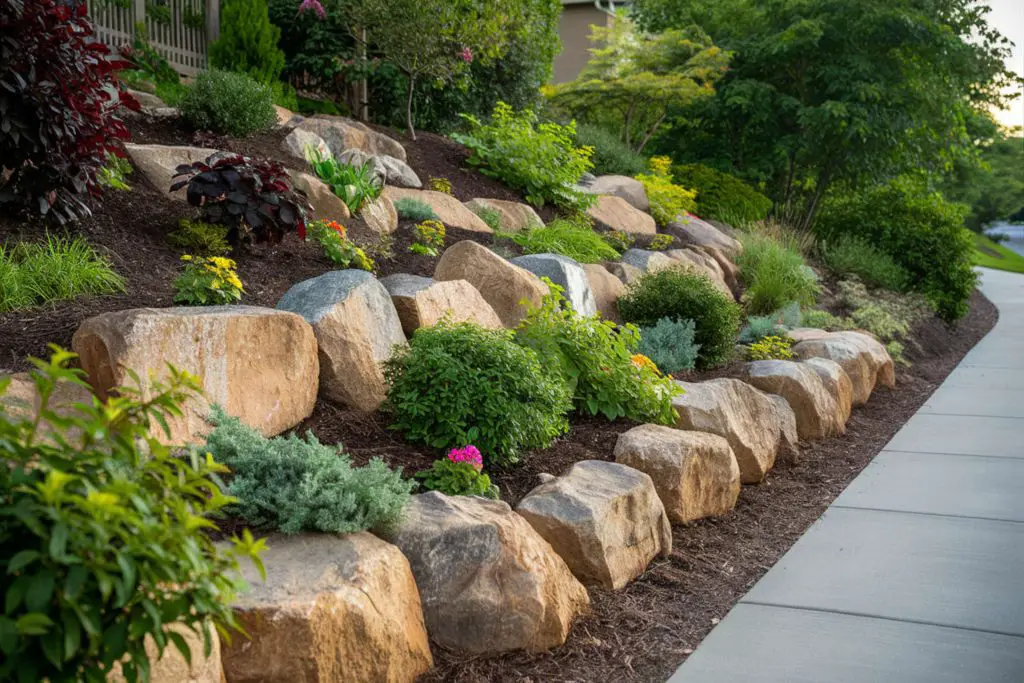
Strategically placing rocks and boulders can help create leveled areas on a slope, offering a natural and visually appealing solution. Rocks and boulders not only provide stability but also enhance the beauty of your garden with their rugged charm.
Using rocks in your landscaping helps with erosion control by slowing down water runoff and holding soil in place. Choose a mix of sizes and shapes to create a more natural look. You can nestle smaller plants among the rocks to soften the edges and add a touch of greenery.
One tip for choosing the right rocks is to match them with the existing elements in your yard. If your garden has a lot of earthy tones, opt for stones in similar shades. In my backyard, I used large flat stones to create a series of small terraces. I planted creeping phlox between the rocks, and the result is a beautiful cascade of flowers each spring.
#6 Creating Stairways: Leveling Down with Stairs
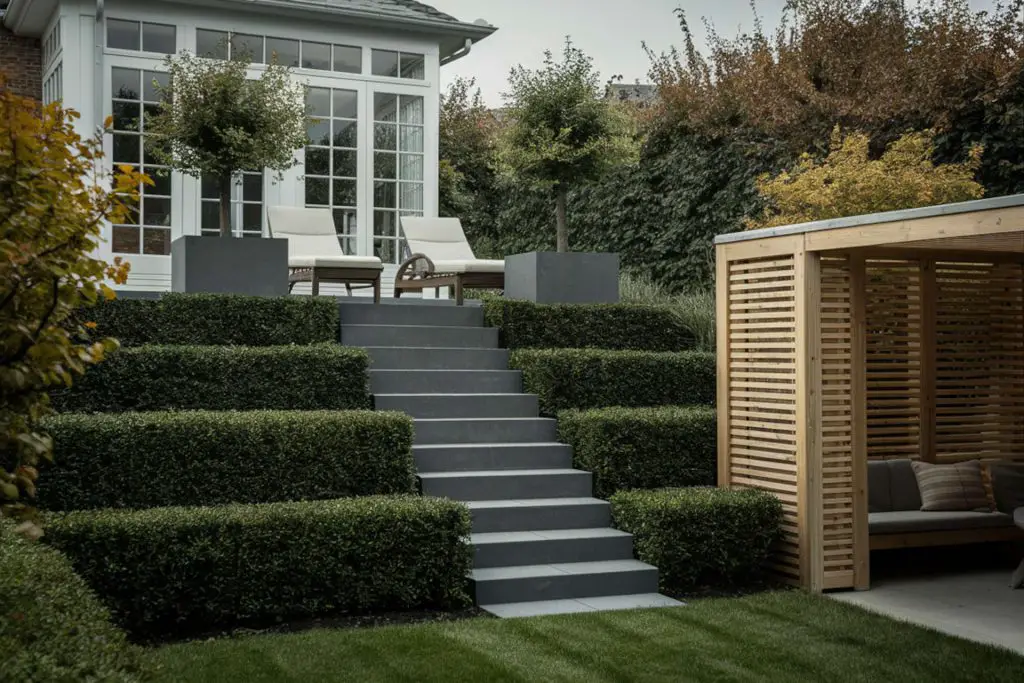
You don’t always have to look to build up a slope. Sometimes a better solution is to dig out the slope and level down into a single flat level.
When utilizing this method, strategically placed stairs can transform a steep slope into usable, accessible level, making your backyard more functional and visually appealing. Stairs not only provide a practical way to navigate your garden but also serve as a charming focal point.
Wood, stone, or concrete stairs can be tailored to match your garden’s style. Incorporating curves or landings adds interest and makes the ascent easier. Stairs can lead to different zones in your garden, each with its own purpose, like a cozy seating area or a vegetable patch.
One unique stair design I’ve seen featured waterfall stairs, where small pools of water cascaded down the sides. It added a tranquil sound and stunning visual element to the garden. Integrating stairs into your slope can truly elevate your outdoor space, making it both beautiful and functional.
#7 Swale Away the Slope: The Power of Swales
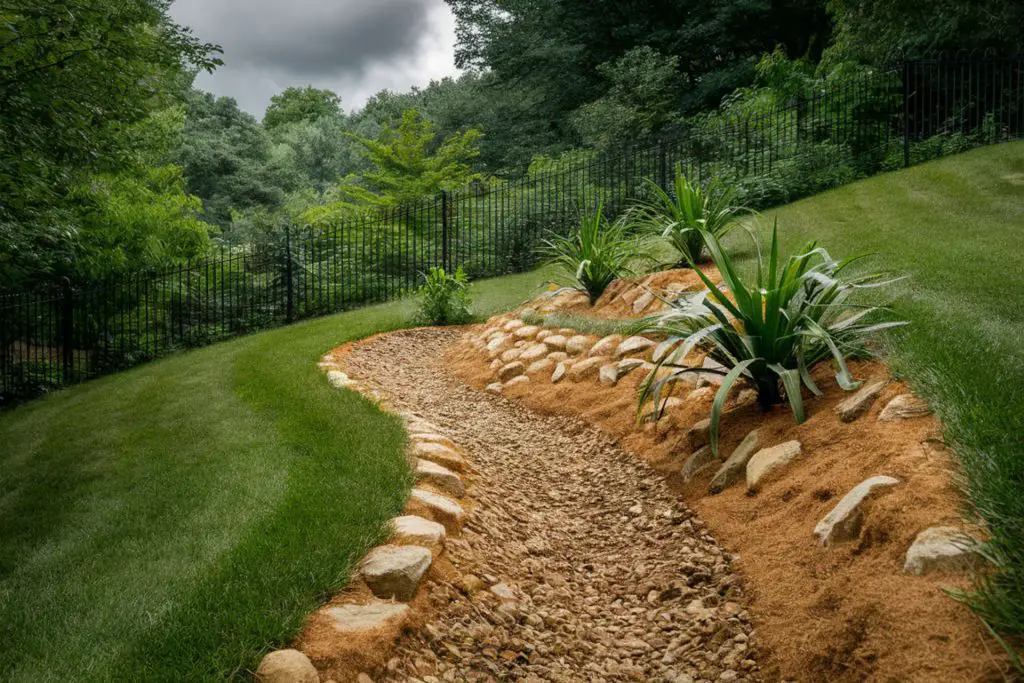
Swales are gently sloped channels designed to collect and redirect water, helping to manage drainage while creating subtle level changes in your garden. This technique is both practical and visually appealing, making it an excellent option for sloped backyards.
By guiding water to where it’s needed most, swales help prevent erosion and keep your garden hydrated. They can be lined with stones or planted with grasses and other vegetation to blend seamlessly into the landscape. Swales not only improve the functionality of your yard but also add a natural, organic feel.
In my own garden, I created a series of swales to manage rainwater runoff. By planting native grasses and wildflowers along the channels, I’ve created a vibrant and low-maintenance area that supports local wildlife and keeps my yard looking lush. Swales are a simple yet effective way to enhance both the beauty and utility of a sloped garden.
#8 Green Tiers: Planting for a Leveled Look
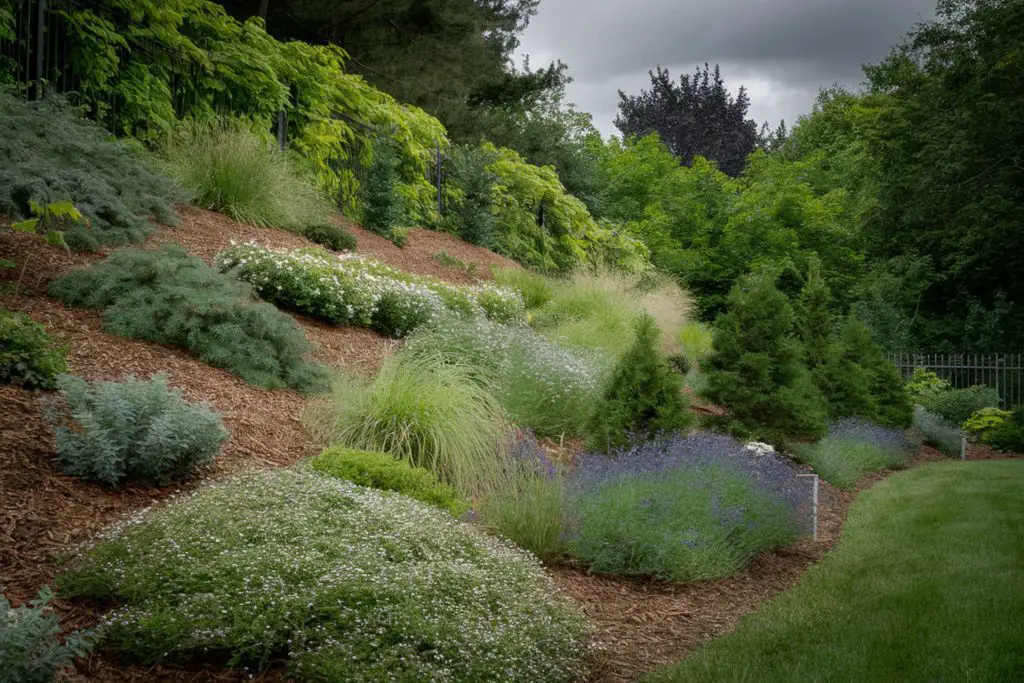
Planting strategically can create a visually leveled effect, transforming a slope into a tiered landscape. By placing low-growing plants on the steeper parts and taller plants on the flatter areas, you can add depth and interest to your garden.
Low-growing groundcovers like creeping juniper or periwinkle help hold soil in place and prevent erosion. Taller plants, such as ornamental grasses or small trees, add height and structure, creating a layered look that makes the most of your sloped terrain.
One of my favorite low-growing groundcovers is creeping thyme. It not only provides excellent erosion control but also produces tiny, fragrant flowers that attract pollinators. Pair it with taller plants like lavender or dwarf conifers to create a balanced and beautiful landscape. This approach not only enhances the visual appeal of your garden but also makes it easier to manage and maintain.
Final Thoughts
Transforming a sloped backyard can be a rewarding challenge. With these eight creative solutions, you can turn that tricky terrain into a stunning and functional space. From terraced lawns and retaining walls to upcycled pallets and strategically placed rocks, there are plenty of ways to level your slope. Raised beds, stairs, swales, and tiered planting further enhance the usability and beauty of your garden.
With a little creativity, we can turn our slopes from a headache to a showstopper! So grab your gardening gloves and let’s get leveling!
